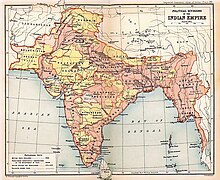
Back التكامل السياسي في الهند Arabic ভারতের রাজনৈতিক একত্রীকরণ Bengali/Bangla Integración política de la India Spanish भारत का राजनीतिक एकीकरण Hindi Integrasi politik India ID ಭಾರತದ ರಾಜಕೀಯ ಏಕೀಕರಣ Kannada संस्थानांचे विलीनीकरण Marathi بھارت دی سیاسی وحدت PNB ඉන්දියාවෙහි දේශපාලනමය සමෝධානය Singhalese இந்தியாவின் அரசியல் ஒருங்கிணைப்பு Tamil

Before India gained independence in 1947, India (also called the Indian Empire) was divided into two sets of territories, one under direct British rule (British India), and the other consisting of princely states under the suzerainty of the British Crown, with control over their internal affairs remaining in the hands of their hereditary rulers. The latter included 562 princely states which had different types of revenue-sharing arrangements with the British, often depending on their size, population and local conditions. In addition, there were several colonial enclaves controlled by France and Portugal. After independence, the political integration of these territories into an Indian Union was a declared objective of the Indian National Congress, and the Government of India pursued this over the next decade.
In July 1946, Jawaharlal Nehru pointedly observed that no princely state could prevail militarily against the army of independent India.[1] In January 1947, Nehru said that independent India would not accept the divine right of kings.[2] In May 1947, he declared that any princely state which refused to join the Constituent Assembly would be treated as an enemy state.[3] Vallabhbhai Patel and V. P. Menon were more conciliatory towards the princes, and as the men charged with integrating the states, were successful in the task.[4] Through a combination of factors, Sardar Vallabhbhai Patel and V. P. Menon coerced and coalesced the rulers of the various princely states to accede to India. Having secured their accession, they then proceeded, in a step-by-step process, to secure and extend the union government's authority over these states and transform their administrations until, by 1956, there was little difference between the territories that had been part of British India and those that had been princely states. Simultaneously, the Government of India, through a combination of military and diplomatic means, acquired de facto and de jure control over the remaining colonial enclaves, which too were integrated into India.
Although this process successfully integrated the vast majority of princely states into India, it was not as successful for a few, notably the former princely states of Jammu and Kashmir and Manipur, where active secessionist and separatist insurgencies continued to exist due to various reasons.
- ^ Menon, Shivshankar (20 April 2021). India and Asian Geopolitics: The Past, Present. Brookings Institution Press. p. 34. ISBN 978-0-670-09129-4. Archived from the original on 14 April 2023. Retrieved 6 April 2023.
- ^ Lumby, E. W. R. 1954. The Transfer of Power in India, 1945–1947. London: George Allen & Unwin. p. 228
- ^ Tiwari, Aaditya (30 October 2017). "Sardar Patel – Man who United India". pib.gov.in. Archived from the original on 15 November 2022. Retrieved 29 December 2022.
- ^ "How Vallabhbhai Patel, V P Menon and Mountbatten unified India". 31 October 2017. Archived from the original on 15 December 2022. Retrieved 29 December 2022.
© MMXXIII Rich X Search. We shall prevail. All rights reserved. Rich X Search